 This story was published in the December 2023 GēDUNK.
This story was published in the December 2023 GēDUNK.
Impact 150: The Anniversary Campaign for Grove City College is more than a historic fundraising and strategic building campaign to position the College for the future, it is a celebration of the history and legacy of Grove City College as it nears its sesquicentennial in 2026.
The College has had a significant impact over the last century and a half – not only on the tens of thousands of students whose lives have been transformed by the lessons learned, relationships formed, and faith fostered on campus – but on a world that has changed dramatically in that time. Over the next few years as we approach our milestone anniversary, we are going to be highlighting 150 for 150, a selection of people who embody 150 years of Grove City College history, and the excellence and faithfulness that are our hallmarks.
This isn’t a list of the “greatest Grovers” – we think all Grovers are great – but a sampling of some of the men and women who have made an impact on the College and the world beyond campus over the decades.
Some are key figures in Grove City College’s history, while others are accomplished alumni, legendary faculty members, or simply beloved members of our community. They shaped – and were shaped by – the distinctive character of this special place. They are exemplars of Grove City College’s mission, vision, and values.
We will roll out 150 for 150 in the pages of the GēDUNK over the next six issues leading up to our anniversary year. To best represent the scope of the College’s impact, each installment will include a cross section of luminaries, presented without regard to any ranking or chronology.
As this and future installments of 150 for 150 will demonstrate, the College’s impact has been felt through these individuals – and too many others with College ties to list – across the decades in business, industry, academia, the church, public service, science, medicine, politics, sport, and culture and in communities large and small, from our beautiful campus to the rest of the wide world.
ISAAC C. KETLER AND JOSEPH NEWTON PEW
Without these two men, there would be no Grove City College. Ketler, the founder, and Pew, the businessman, built the College from the ground up. The educational and institutional foundation they established in the last quarter of the 19th century remains as rock solid as the faith that guided their work.
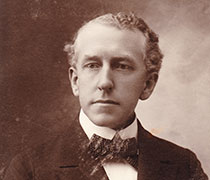 Isaac C. Ketler
Isaac C. Ketler
Ketler was the visionary. A native of Northumberland, Pa., and devout Presbyterian, his passion for education was fostered in a one-room schoolhouse in London, Pa., where Pew, born on a farm outside of Mercer, Pa., was the teacher.
At age 16, Ketler attended Edinboro Academy, a private training school for teachers that is now part of Penn West University, and taught for a short time after graduation at a school in Scrubgrass Township north of Grove City. He went on to study at National Normal University. In subsequent years, he would earn master’s, doctorate, and divinity degrees from various institutions.
In 1876, at the age of 23, Ketler was hired by the town of Pine Grove, Pa., to lead its namesake academy, a preparatory school for students interested in teaching, the professions, or further education at a four-year college or university. Pine Grove Normal Academy was a public venture, with stockholders and local citizens and church leaders overseeing its operation and funding. The first class of 13 students met in a second floor classroom.
Ketler believed that education was essential to prepare young people for a rapidly changing world and a future that would demand both knowledge and good character. Under his guidance, the academy grew and expanded its curriculum beyond professional training. It began offering four-year degrees and in 1884 it became Grove City College.
While Ketler pursued a career in education, Pew had left teaching to seek his fortune in the burgeoning oil boom in western Pennsylvania. At one point, Pew tried to recruit his former pupil to join him in business, but Ketler declined.
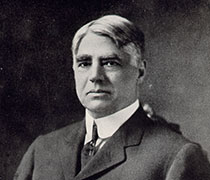 Joseph N. Pew
Joseph N. Pew
Pew started Keystone Gas Company, which used natural gas to provide heat and light for communities. By 1882, he was delivering gas to Pittsburgh and owned the Haymaker gas well in Murrysville, Pa., then the largest in the world. Pew established the Sun Oil Line Co., which would later become known as Sunoco and developed Peoples Natural Gas Company. A master businessman, Pew was a faithful Christian and devoted Presbyterian who built a legacy in industry and philanthropy.
Ketler reached out to his former teacher to support the College. “Years ago, you asked me to go into business with you. Now I have come to ask you to go into business with me,” Ketler reportedly said.
Pew agreed and helped Ketler recruit other regional business leaders to serve on the Board of Trustees and reorganize the College as a nonprofit institution. A new charter that declared Grove City College was “an undenominational but evangelical Christian school” was approved in 1895 and Pew was elected chairman of the board.
Pew provided leadership and generous financial support to the College that enabled it to grow as the century turned. Under the guidance of Ketler and Pew, the College grew exponentially. By 1900 enrollment was nearing 700 students and the campus had grown to a cluster of buildings and grounds stretching from Broad Street to Wolf Creek. The stage was set for a century of steady expansion and impact.
The Ketler-Pew partnership continued to benefit the College beyond Pew’s death in 1912 and Kelter’s a year later. Their sons, Weir C. Ketler and J. Howard Pew, would take their fathers’ places in the president’s office and on the board, respectively, and continue their families’ service to the College well into the 20th century.
HANS SENNHOLZ
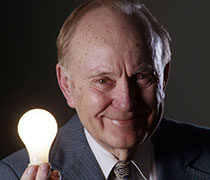 Hans Sennholz, the renowned economist and legendary professor, impacted thousands of students over five decades, not just as a proponent of the Austrian School but as an inspiring and challenging teacher and mentor.
Hans Sennholz, the renowned economist and legendary professor, impacted thousands of students over five decades, not just as a proponent of the Austrian School but as an inspiring and challenging teacher and mentor.
For a large part of the 20th century, Sennholz, his heavy German accent, his writings on economic theory, and his high expectations for his students embodied the rigorous academics and conservative character for which Grove
City College is known. His impact was felt far from campus and on a much bigger stage as an influence on the views of economists around the world and the conservative movement through his work with think tanks and via his many writings. Ronald Reagan was a fan.
Sennholz was “one of our nation’s most articulate, intellectual voices for ordered liberty, limited government, and free markets,” former College President Richard G. Jewell ’67 said upon the professor’s passing in 2007. “As a classroom teacher he had few peers. His lucid and clearly reasoned written work inspired and informed the many who relied on his economic guidance.”
Born in Germany in 1922, Sennholz experienced the deprivations of the Great Depression and the rise of Nazism. Drafted into the Luftwaffe, he earned the Iron Cross as a fighter pilot before being shot down on a mission over Egypt in 1942. He was held as prisoner of war, eventually in the U.S., where he worked on an Arkansas dairy farm.
After the war he returned to Germany and earned his master’s degree at the University of Marburg and his first doctorate from the University of Cologne. He returned to the U.S. to study at New York University under the great Austrian economist Ludwig Von Mises and earned his Ph.D. in 1955. A year later, at the behest of J. Howard Pew, he joined the faculty at Grove City College where he served as professor of Economics and chairman of the Department of Economics for the next 36 years.
He was the author of 17 books and booklets, from Divided Europe in 1955 to Reflection and Remembrance in 1997 and published more than 500 essays and articles. Other works include Debts and Deficits, The Politics of Unemployment, and Age of Inflation.
After retirement in 1992, he continued writing and working with think tanks and remained an integral part of Grove City College. On his 81st birthday, he delivered the first lecture in Sticht Lecture Hall, which had just opened. Two years later, he gave the closing lecture at the first conference held by The Center for Vision & Values at Grove City College. Now known as The Institute for Faith & Freedom, the campus think tank is a part of Sennholz’s legacy.
His wife, Mary, was also a scholar and author. Her four books include Faith and Freedom: A Biographical Sketch of a Great American: J. Howard Pew. Their son, Robert ’75, and grandson, Roland ’08, are alumni.
NANCY (LEE ’54) PAXTON
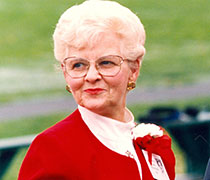 Nancy (Lee ’54) Paxton is one of Grove City College’s great characters. She left an indelible mark on thousands of Grovers in a succession of roles, including Dean of Women and Vice President for Student Affairs.
Nancy (Lee ’54) Paxton is one of Grove City College’s great characters. She left an indelible mark on thousands of Grovers in a succession of roles, including Dean of Women and Vice President for Student Affairs.
She served the College for 28 years and a generation after she retired in 2004, we’re reminded of enduring presence whenever someone invokes her famous freshmen orientation catchphrase, a prediction that has inspired countless “ring by spring” quests: “Look to the left, look to the right, your future mate might be in sight.”
“With her signature red suit, and her heart of gold, Nancy Paxton was a true Grover. Her children were each of the students she interacted with at the College. She gave so much of her time, energy and spirit to making the campus a memorable place. Mrs. Paxton had a passion for Grove City College that can’t be measured, and she truly made a mark on her alma mater,” Senior Director of Alumni and College Relations Melissa (Trifaro ’96) MacLeod said.
Her job, and her passion, was always taking care of students. Known for her humor and compassion, Paxton took a sincere interest in students’ well being and was a source of encouragement. From her etiquette diners to her Faculty Follies antics, she was a supportive and positive influence on all she encountered.
In 1994, Paxton was a recipient of a Jack Kennedy Memorial Alumni Achievement Award in the field of education. Upon her retirement she was awarded an honorary Doctor of Humane Letters degree from the College, which she considered a tremendous honor.
A member of the “Great Class of 1954,” which also included Dean of Chapel Richard Morledge, Paxton was a religious educator before coming to work at Grove City College.
DAVID R. RATHBURN ’79
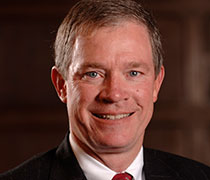 Board of Trustees Chair Emeritus David R. Rathburn ’79 has the distinction of being the only person to serve as both Chair of the Board and president of the College. Though the latter position was held on an interim basis between the tenures of John H. Moore and Richard G. Jewell ’67, Rathburn’s appointment to it attests to the key leadership role he played over the course of three decades.
Board of Trustees Chair Emeritus David R. Rathburn ’79 has the distinction of being the only person to serve as both Chair of the Board and president of the College. Though the latter position was held on an interim basis between the tenures of John H. Moore and Richard G. Jewell ’67, Rathburn’s appointment to it attests to the key leadership role he played over the course of three decades.
He joined the College’s Board in 1992 and was elected chair in 2003, a position he held for 17 years. Rathburn helped lead the College during a period of unprecedented growth and change: extricating itself from the federal student loan program; establishing a robust network of financial support; becoming one of the premier Christian colleges in the U.S.; raising half a dozen new structures – including a namesake Christian activities building; restoring numerous buildings and working with four College presidents. He was also a key figure in establishing the Charles Jr. and Betty Johnson School of Nursing.
With degrees in accounting, business administration, and political science, Rathburn went to work after graduation for Price Waterhouse before joining Grove City College-connected Hopeman Brothers Marine Division. He worked for the company in various capacities before being named president in 1991 at age 33. He served in that position for 22 years before forming marine interior outfitter US Joiner LLC.
During his years as a student, Rathburn was vice president of the Student Government Association, a Nu Lambda Phi brother, and the sports director for radio station WSAJ-FM, serving as the voice of the Wolverines announcing home and away football and basketball games.
His sons Tyler ’18 and Mark ’08 are alumni.
JACK BEHRINGER – A 40-year athletic director, department chair, and coach, he expanded campus sports and coached football for 17 years, including the undefeated 1966 season, and the baseball team for 29.
ANNA LONG ’44 – A pioneering woman of science, she blazed a trail for others at American Cyanamid and Dupont before transitioning to teaching.
BRUCE THIELEMANN – Dean of Chapel from 1974 to 1984, he was an internationally acclaimed preacher and theologian who inspired many students to lead lives of faith.
RUTH (BOGERT ’63) WIBLE – The first woman to earn a varsity letter at the College, she was a record-setting member of the rifle team from 1959 to 1963.
SAMUEL P. HARBISON – A Pittsburgh industrialist, he was a member of the Board of Trustees in the 1890s and namesake of the Chapel built with a family gift.
PAUL KENGOR – An accomplished professor, author, and in-demand political and cultural commentator, he is a noted Reagan biographer, cold war historian, and leader of the Institute for Faith & Freedom.
DALE SMOCK ’42 – On the Engineering faculty for 35 years, he attended U.S. Naval Training School at the College during WWII and was key to development and growth of the College radio station.
JOHN H. MOORE – The College’s seventh president, he served from 1996 to 2003, led Grove City College out of the federal student loan program and bolstered academic standards.
MARY ETHEL PEW – Philanthropist, College benefactor and former Trustee, she was the namesake of the women’s residence hall built in 1981.
FRED FETTEROLF ’52 – After earning a degree in Chemistry, he climbed the ranks at ALCOA to become president and COO. He also served on the Board of Trustees.
RICHARD LEO – Beloved Physics professor who made the mysteries of the discipline clear to generations of students. The science faculty icon retired in 2004 as professor of the year.
CHARLIE BERRY – Football and baseball coach in the 1930s who played for the NFL and MLB and was a long time official in both leagues.
ANDREW HOFFECKER – The former faculty member was one of the chief architects of the Keystone Curriculum in the 1970s, which later developed into the Humanities core.
HILDA KRING – English professor and friend to generations of students, she founded the Children’s Theatre program and was the first winner of the Florence MacKenzie Campus Community Award.
ED NAEGELE – Professor and longtime chair of the Department of Chemistry, he influenced generations of science and other majors between 1958 and 1990.
BETSY (BOAK ’77) CRAIG – A professor of English and Theatre, she is the director of the College’s nationally acclaimed Theatre Program.
HERBERT HARMON – A Physics professor and technological pioneer, he was responsible for one of the first radio broadcasts in the country in 1920.
JEAN ALICE WILSON ’50 – Influential professor of Education and the first woman to chair the Department of Education at the College, she taught from 1959-1982.
ALEXANDER ORMOND – The second president of the College and a leading academic of the time, he served in interregnum between the terms of Isaac and Wier C. Ketler and died suddenly in office in 1913.
BYOUNG-HYE CHANG ’56 – A native of South Korea and daughter of its third prime minister, she earned a Ph.D. from Georgetown University and was a professor at Seton Hall University and a bilingual author.